Kingston SSDNow V300 (120GB & 240GB) Review
by Kristian Vättö on April 30, 2013 12:30 PM ESTAnandTech Storage Bench 2011
Two years ago we introduced our AnandTech Storage Bench, a suite of benchmarks that took traces of real OS/application usage and played them back in a repeatable manner. Anand assembled the traces out of frustration with the majority of what we have today in terms of SSD benchmarks.
Although the AnandTech Storage Bench tests did a good job of characterizing SSD performance, they weren't stressful enough. All of the tests performed less than 10GB of reads/writes and typically involved only 4GB of writes specifically. That's not even enough exceed the spare area on most SSDs. Most canned SSD benchmarks don't even come close to writing a single gigabyte of data, but that doesn't mean that simply writing 4GB is acceptable.
Originally we kept the benchmarks short enough that they wouldn't be a burden to run (~30 minutes) but long enough that they were representative of what a power user might do with their system. Later, however, we created what we refer to as the Mother of All SSD Benchmarks (MOASB). Rather than only writing 4GB of data to the drive, this benchmark writes 106.32GB. This represents the load you'd put on a drive after nearly two weeks of constant usage. And it takes a long time to run.
1) The MOASB, officially called AnandTech Storage Bench 2011—Heavy Workload, mainly focuses on the times when your I/O activity is the highest. There is a lot of downloading and application installing that happens during the course of this test. Our thinking was that it's during application installs, file copies, downloading, and multitasking with all of this that you can really notice performance differences between drives.
2) We tried to cover as many bases as possible with the software incorporated into this test. There's a lot of photo editing in Photoshop, HTML editing in Dreamweaver, web browsing, game playing/level loading (Starcraft II and WoW are both a part of the test), as well as general use stuff (application installing, virus scanning). We included a large amount of email downloading, document creation, and editing as well. To top it all off we even use Visual Studio 2008 to build Chromium during the test.
The test has 2,168,893 read operations and 1,783,447 write operations. The IO breakdown is as follows:
| AnandTech Storage Bench 2011—Heavy Workload IO Breakdown | ||||
| IO Size | % of Total | |||
| 4KB | 28% | |||
| 16KB | 10% | |||
| 32KB | 10% | |||
| 64KB | 4% | |||
Only 42% of all operations are sequential; the rest ranges from pseudo to fully random (with most falling in the pseudo-random category). Average queue depth is 4.625 IOs, with 59% of operations taking place in an IO queue of 1.
Many of you have asked for a better way to really characterize performance. Simply looking at IOPS doesn't really say much. As a result we're going to be presenting Storage Bench 2011 data in a slightly different way. We'll have performance represented as Average MB/s, with higher numbers being better. At the same time we'll be reporting how long the SSD was busy while running this test. These disk busy graphs will show you exactly how much time was shaved off by using a faster drive vs. a slower one during the course of this test. Finally, we will also break out performance into reads, writes, and combined. The reason we do this is to help balance out the fact that this test is unusually write intensive, which can often hide the benefits of a drive with good read performance.
There's also a new light workload for 2011. This is a far more reasonable, typical every day use case benchmark. It has lots of web browsing, photo editing (but with a greater focus on photo consumption), video playback, as well as some application installs and gaming. This test isn't nearly as write intensive as the MOASB but it's still multiple times more write intensive than what we were running last year.
We don't believe that these two benchmarks alone are enough to characterize the performance of a drive, but hopefully along with the rest of our tests they will help provide a better idea. The testbed for Storage Bench 2011 has changed as well. We're now using a Sandy Bridge platform with full 6Gbps support for these tests.
AnandTech Storage Bench 2011—Heavy Workload
We'll start out by looking at average data rate throughout our heavy workload test:
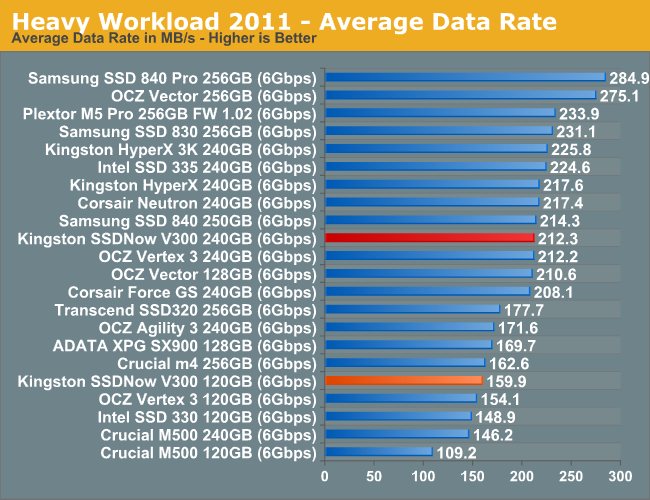
Our Heavy suite also shows that the V300 performs similarly to most SandForce based SSDs. The HyperX is slightly faster but if you're looking for the fastest SSD, then Samsung SSD 840 Pro or OCZ Vector is your best choice.

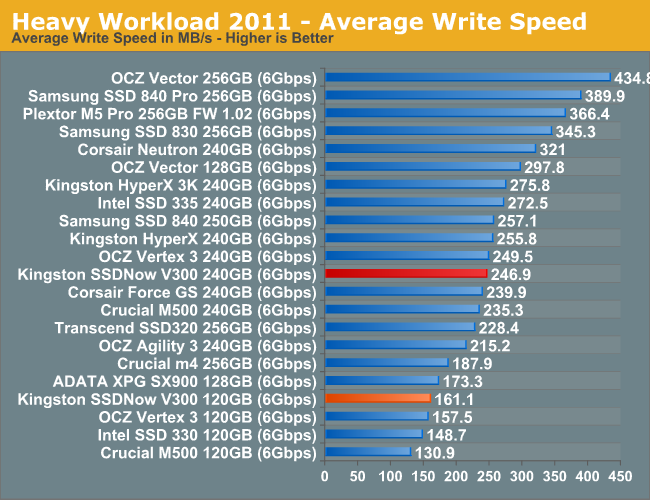
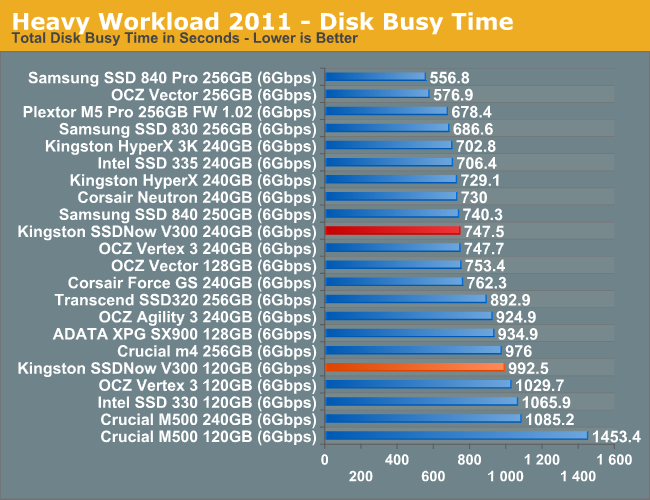
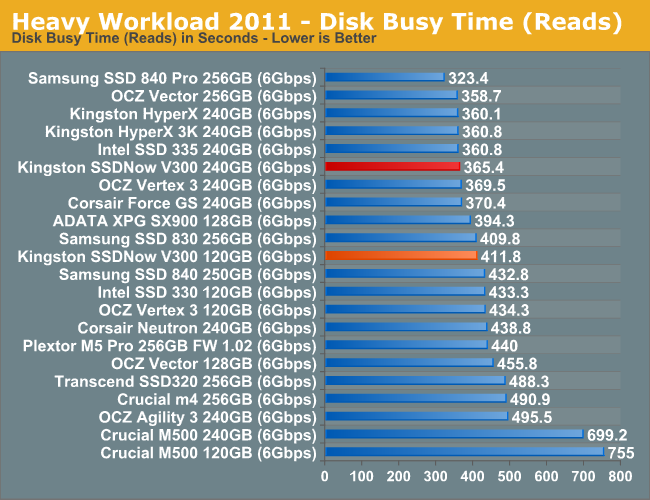
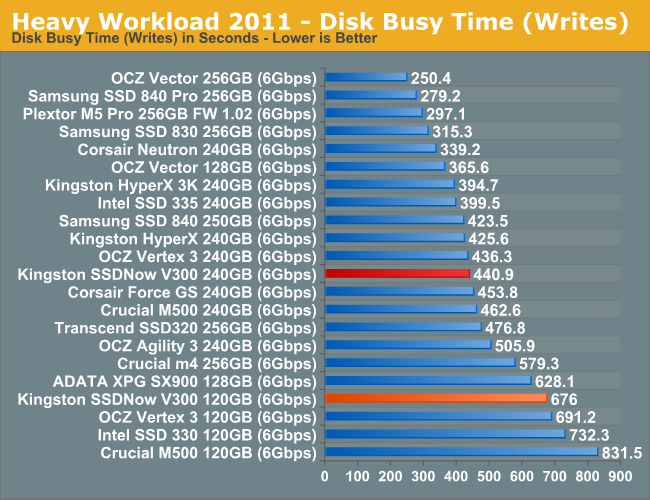










43 Comments
View All Comments
gamoniac - Tuesday, April 30, 2013 - link
Kristian, you forgot to throw in the SSDNow KC100 series in the mix :) It uses SandForce controller, too. That aside, I have five Kingston SSDs; some running 24x7 without issue (knock on wood). Kingston SSDNow lines are pretty attractive a year or two ago when they went on sale with $50 mail-in rebate on Buy.com and Newegg. Nowadays though SSD prices are a lot more competitive. I agree that they need to change their marketing/pricing strategy to stand out from the competitions.ericgl21 - Wednesday, May 1, 2013 - link
How did you TRIM the V300 in Windows 7? There is no "Optimize" option like in Windows 8.And the Kingston Toolbox v1.0 does not have it either (Intel SSD Toolbox does have it, but only works for Intel SSDs).
Kristian Vättö - Wednesday, May 1, 2013 - link
Formatting the drive in Disk Management triggers TRIM.Diagrafeas - Friday, May 3, 2013 - link
I don't understand this.Formatting should trigger Secure Erase.
If it only triggers trim then data isn't erased right?
Kristian Vättö - Friday, May 3, 2013 - link
Secure erase is a different command which cannot even be issued in Windows without specific software. Secure erase basically gets rid of the whole indirection table and erases all LBAs (even the ones inaccessible to the user which are used for e.g. garbage collection and wear leveling).TRIM, on the other hand, just tells the controller that these LBAs are no longer in use and the drive's garbage collection can get rid of them when the time is right. Formatting is the same as TRIMing all user-accessible LBAs, so the controller should get rid of (nearly) all data in the drive and hence returning it to fresh state (the problem is that garbage collection works differently in every SSD and the TRIM command is also treated a bit differently).
ericgl21 - Sunday, May 5, 2013 - link
So in Windows 7, there is no way to TRIM a Kingston SSD without losing the data on it?One must format it?
How come Intel SSD Toolbox can issue a TRIM command for Intel SSDs (which usually takes only a few seconds) without harming any of the user's data on it? They are based on Sandforce controller as well.
leexgx - Tuesday, January 13, 2015 - link
No its done as files are deleted (once a file is deleted the drive is told that it's gone and trim happens when the drive is idle)clarkn0va - Wednesday, May 1, 2013 - link
Kingston Value RAM is a great product in my estimation. It's priced reasonably, performs predictably and has a lifetime warranty, although you'll rarely need to exercise it.Kingston flash products, on the other hand, I'm totally finished with. I bought a dozen or so SSDNow drives about three years back and saw many of them fail in the first and second year. TRIM was never available on these drives, although the competition all had it, and firmware updates were non-existant.
Meanwhile, Kingston USB sticks underperform, and there is little consistency across product lines. From what I've read, Kinsgston-branded flash comes from a whole variety of manufacturers, resulting in poor and inconsistent performance.
I like my Kingston RAM, but for SSDs and USB storage, I'll stick to the proven performers.
SharpieTM - Wednesday, May 1, 2013 - link
I was going to say the same thing. I have a couple 32GB ECC Memory kits from Kingston running, and they are running well. Had more issues with Corsair Memory in my time than with Kingston.But on the SSD and Flash drive front, Kingston is far behind the competition. My feeling is that they are trying to charge for the logo and not the performance. This is a business strategy that will surely end bad. After a couple bad experiences with Kingston and OCZ, my current two go-to manufacturers for SSD's are Intel and Samsung. I have had zero issues with at least a dozen of them.
Deo Domuique - Friday, May 3, 2013 - link
The only reason I would consider buying this, is the 60GB version! I find the 60GB to be the perfect size for an OS/Updates/Drivers/Browser drive. No more, no less.